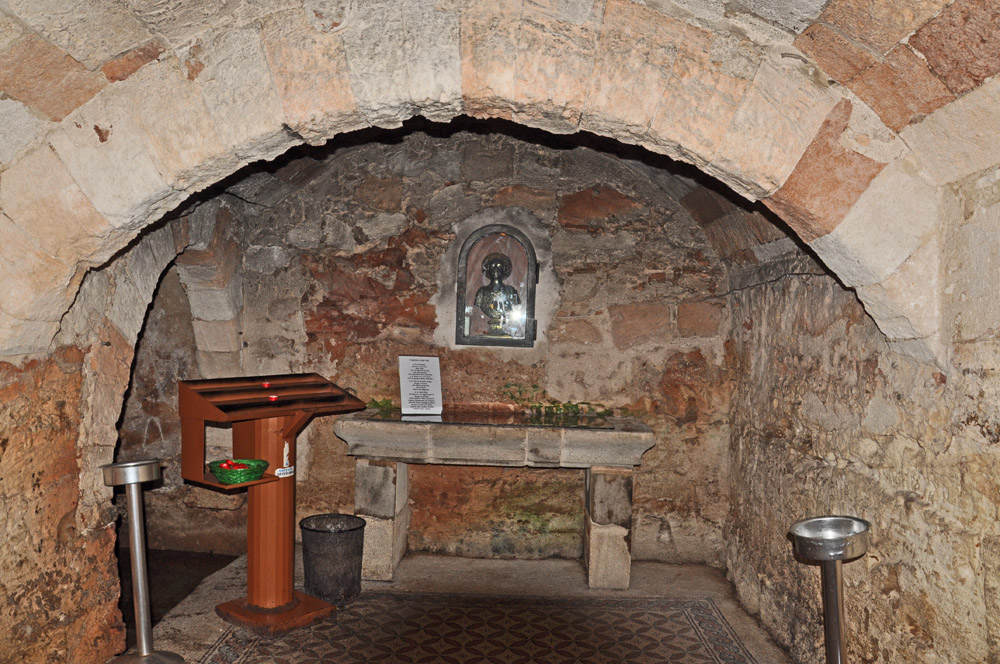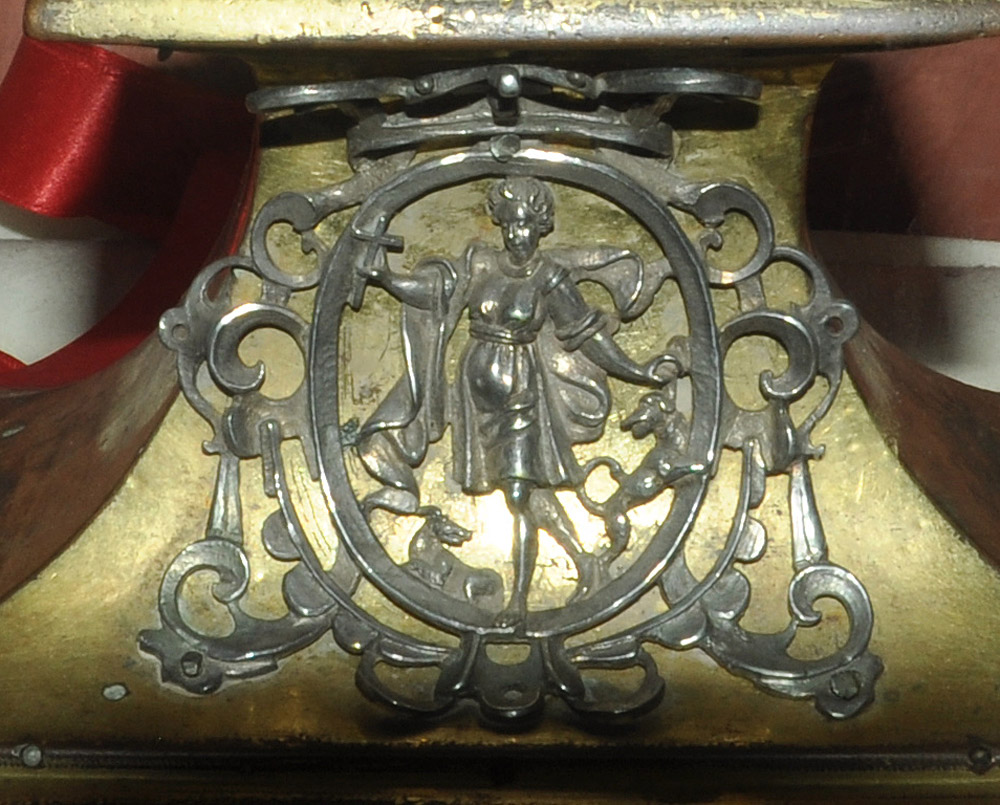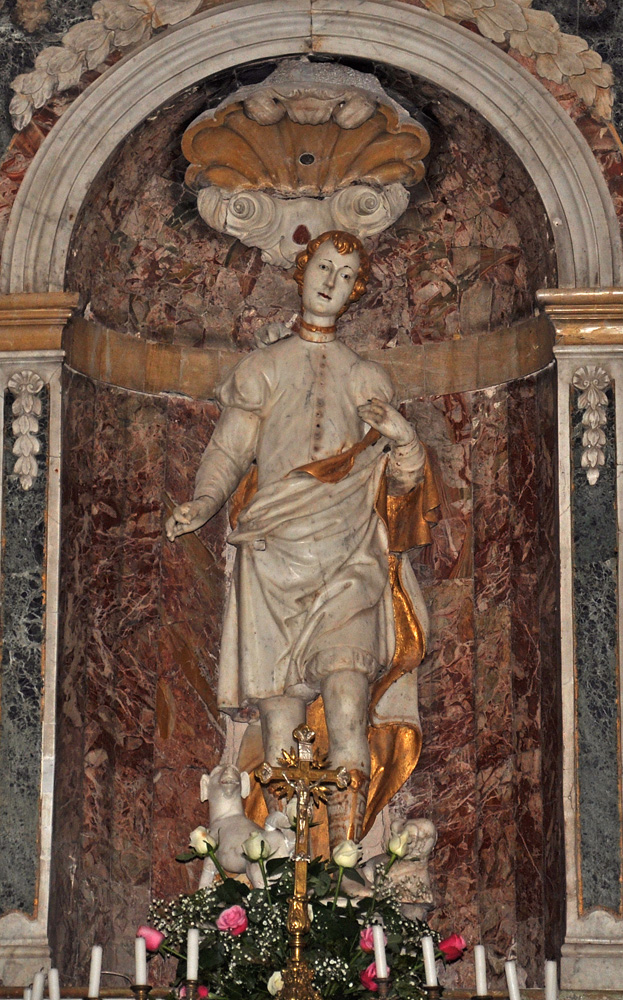St. Vitus is customarily pictured as a youth with curly blond hair. He saved himself from the lions and the molten lead by making the sign of the cross, so in some images he holds a cross (example). In San Vito lo Capo, the town named for him in Sicily, the attribute in his images is a dog or pair of dogs, as in the first picture at right. There is also a dog in this portrait in a church in Rome. In the 17th century the historian Rocco Pirri noted that in San Vito lo Capo the saint was invoked for protection against the bite of rabid dogs. To this day a spring with healing waters is maintained beneath his church, where Pirri says the saint saved a boy that a dog had bitten and left its teeth in his arm.3

Prepared in 2020 by Richard Stracke, Emeritus Professor of English, Augusta University.
HOME PAGE

A pair of dogs serve as the saint's attribute in a medallion of St. Vitus at the base of the reliquary bust in the crypt beneath the church in San Vito lo Capo, Sicily. (See the description page.)

The reliquary bust.

A statue of Saint Vitus in his church in San Vito lo Capo. At his feet are dogs, his attributes. (See the description page.)
MORE IMAGES
- 16th century: This predella in St. Vitus Church, Flein, Germany, pictures St. Vitus in the vat of molten lead.
-
The coat of arms of the city of Flein
 features St. Vitus in the vat of molten lead. As in the predella, he folds his hands in prayer.
features St. Vitus in the vat of molten lead. As in the predella, he folds his hands in prayer.
NAMES
- In Italy, San Vito or Guido
- In Germany, Sankt Veit
- In Britain, St. Guy
DATES
- Feast day: June 15.
- Diocletian reigned 284-305, but not from Rome.
BIOGRAPHY
- Golden Legend #82: Caxton's translation or Ryan's (II, .
- Acta Sanctorum, June vol. 3, 1013-42.
NOTES
1 In the Golden Legend Voragine has the three die from being tortured on an equuleus, which is unambiguously a rack (Graesse, 351). Caxton's translation, however, takes earlier statements that they were "stretched" on a catasta to mean they were "hanged on a gibbet." Catasta can indeed mean a gibbet or scaffold, but Caxton's interpretation would not be consistent with the context of those earlier statements. Following on the phrase about stretching, the earliest vita continues, torquebantur autem in catasta Sancti Dei, ita ut dissiparentur ossa eorum , "they were twisted on the catasta till their bones came apart." The Latin verb in that phrase can mean "tortured on a rack" (Lewis and Short, s.v. torqueor, IIIB), and of course mere hanging on a gibbet would not pull all one's bones apart. Thus it is clear that in using the word equuleus Voragine was following the traditional understanding, and that Caxton's interpretation is an outlier.
2 The Acta Sanctorum (June vol. 2) has a vita from the 6th or 7th century on pages 1020-26 and Ado of Vienne's 9th-century summary with all the basic elements of that vita on p. 1013. In the 13th century the Golden Legend made Valerian provost of Lucca rather than Sicily, aged the boy to 12 years old, and changed the vat of molten lead to "a fiery furnace." The latter change can be traced to Vitus's prayer when he and Modestus and Crescentia are placed in boiling cauldrons: "Lord, hasten and free us from this torment, as you freed the three youths from the fiery furnace…" (Acta Sanctorum, ibid., 1024, my translation) and to Ado's statement that in the cauldrons the three "sang a hymn to God in the manner of the three youths," a reference to the Canticum Trium Puerorum which is recited daily in the Divine Office.
3 Pirri's Sicilia Sacra is quoted in Acta Sanctorum, ibid., 1014.
3 Photo taken in 2014 by Richard Stracke, shared under Attribution-NonCommercial-ShareAlike license.